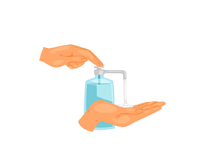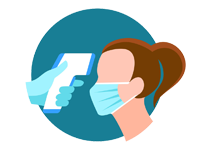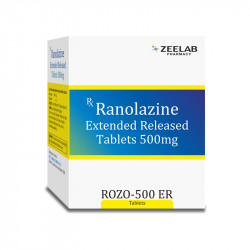Ranolazine
Ranolazine is a medication primarily used to treat chest pain (angina) in people with heart disease. It works by improving blood flow to the heart, helping it work more efficiently. Ranolazine is often used in combination with other medications to manage angina. It does not relieve acute chest pain but helps reduce the frequency and severity of angina episodes over time, enhancing overall quality of life.
Uses of Ranolazine
- Treatment of chronic angina (chest pain) in people with coronary artery disease
- Helps reduce the frequency and intensity of angina episodes
- Improves exercise tolerance and quality of life for patients with angina
How Ranolazine Works
Ranolazine works by affecting the sodium and calcium levels inside heart cells. This helps reduce the heart's oxygen demand and improves blood flow, thereby reducing chest pain. Unlike other angina medications, Ranolazine does not lower heart rate or blood pressure but helps the heart muscle to use oxygen more efficiently.
Benefits of Ranolazine
- Reduces the frequency of angina episodes
- Improves the ability to perform physical activities and exercise
- Has fewer side effects compared to other angina medications
- Can be used alongside other heart medications for comprehensive treatment
How to Take Ranolazine
Ranolazine is typically taken orally in the form of a tablet. The usual dosage is one tablet (500 mg) twice daily, but the exact dose will be determined by your doctor based on your individual condition. It should be swallowed whole with or without food. Do not crush or chew the tablet, as it may affect how the medication works.
Types of Dosage Available
- 500 mg Tablet
- 1000 mg Tablet
Side Effects of Ranolazine
- Dizziness or lightheadedness
- Headache
- Constipation
- Nausea
- Swelling in the legs or feet
- Uncommon but serious side effects include irregular heartbeats and liver issues
Safety Advice
- Consult your doctor before using Ranolazine if you have liver or kidney problems.
- Avoid grapefruit and grapefruit juice while taking this medication as it may interact with Ranolazine.
- Inform your healthcare provider of all other medications you are taking to prevent drug interactions.
- Pregnant or breastfeeding women should only take Ranolazine if prescribed by a doctor after assessing risks.
Frequently Asked Questions (FAQs)
Q: What is Ranolazine used for?
A: Ranolazine is used to treat chronic angina (chest pain) and improve exercise tolerance in patients with coronary artery disease.
Q: How does Ranolazine work?
A: Ranolazine works by improving the flow of oxygen to the heart and reducing the heart's oxygen demand, helping to prevent chest pain without affecting heart rate or blood pressure.
Q: How should I take Ranolazine?
A: Take one tablet twice a day, as directed by your doctor. The tablet should be swallowed whole with or without food. Do not chew or crush it.
Q: What are the common side effects of Ranolazine?
A: Common side effects include dizziness, constipation, headache, and nausea. Serious side effects may include irregular heartbeats or liver issues, so seek medical attention if needed.
Q: Can I take Ranolazine with other medications?
A: Yes, Ranolazine can be used alongside other medications for angina, but inform your doctor about any other drugs you are taking to avoid potential interactions.
Download India's most affordable pharmacy app
- Compare with medicine prices
- Save upto 90% on your medicine bills

Temperature Controlled storage and delivery

Regular Sanitization

Disinfected Packaging















 Added!
Added!